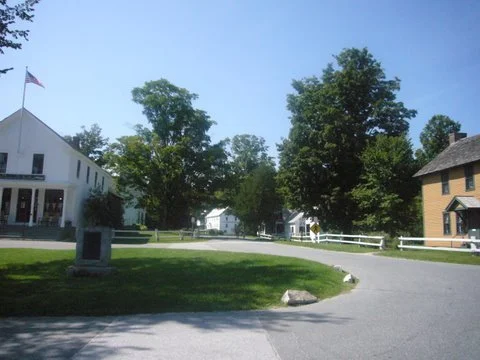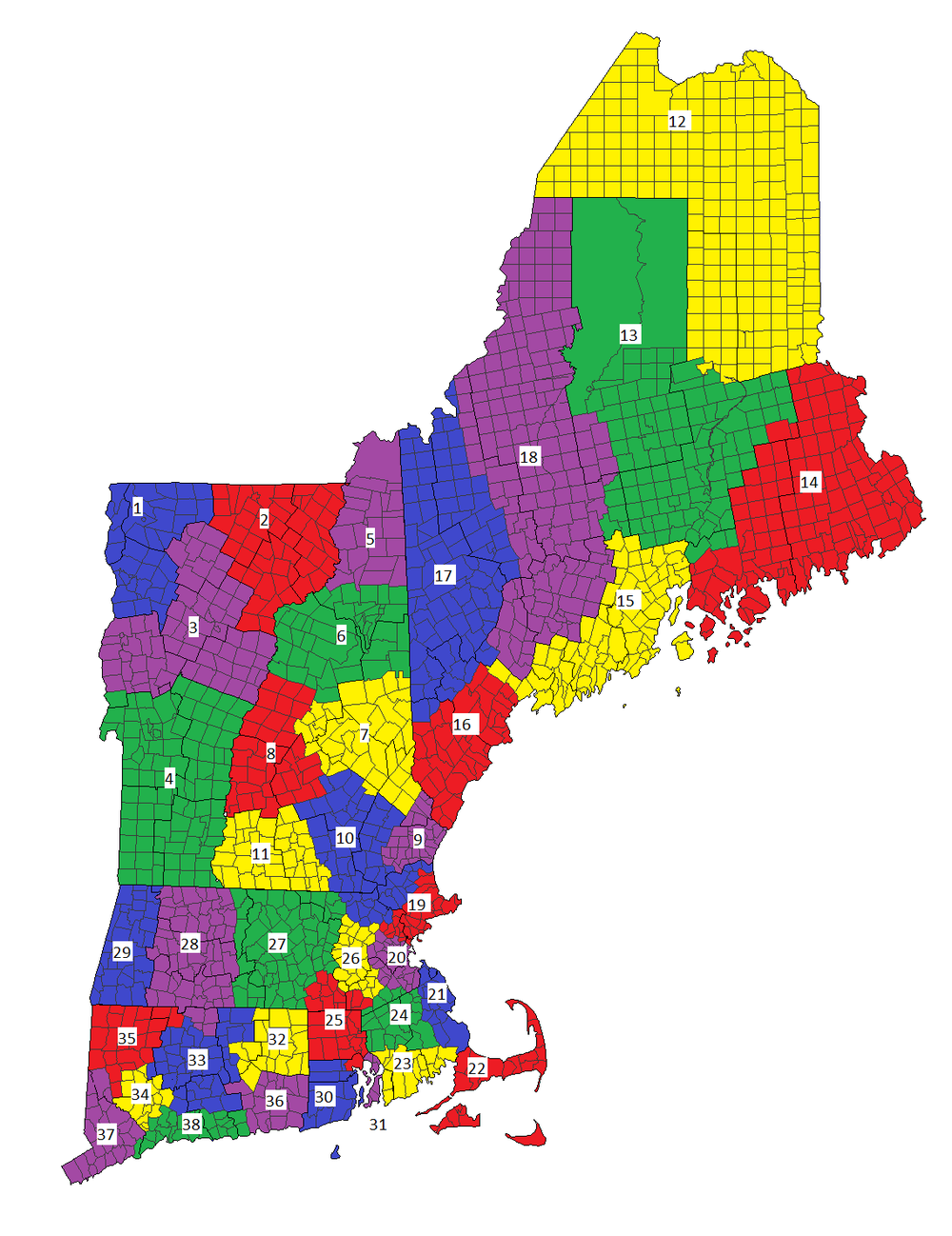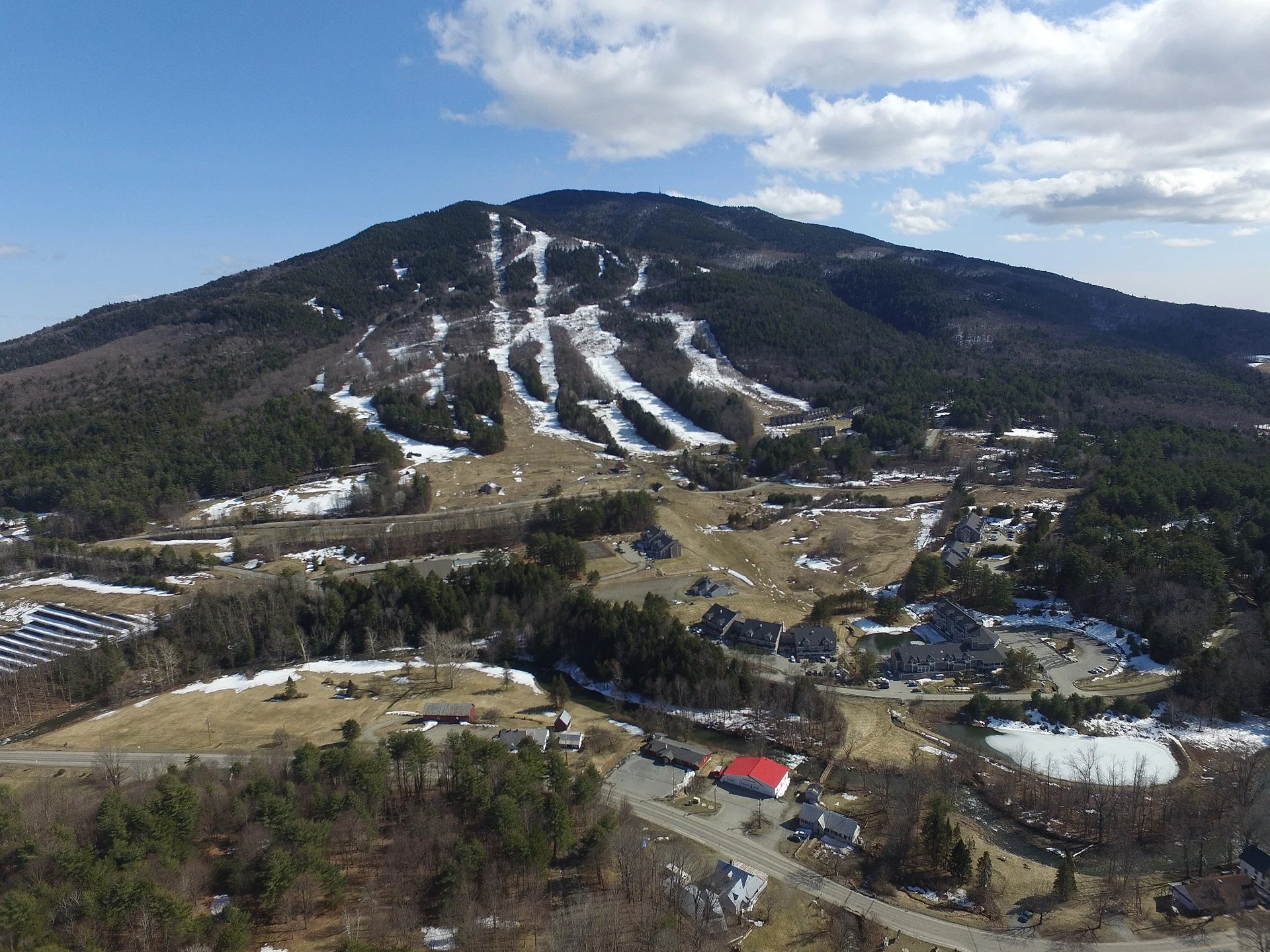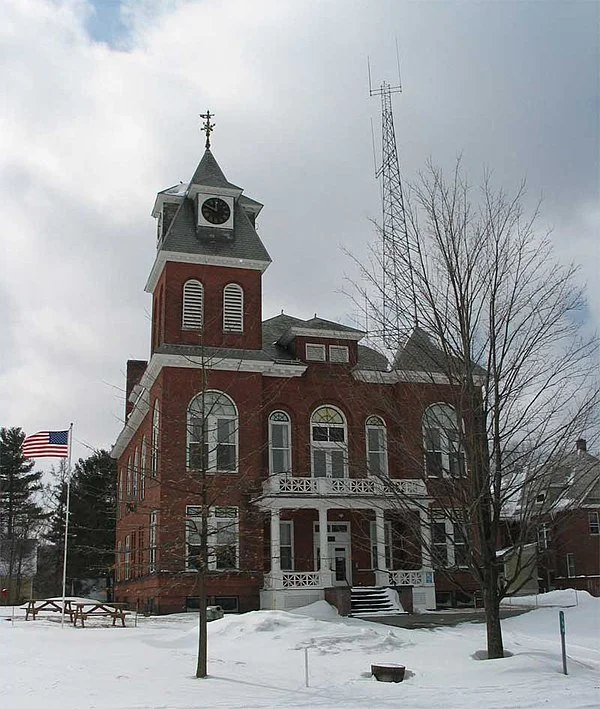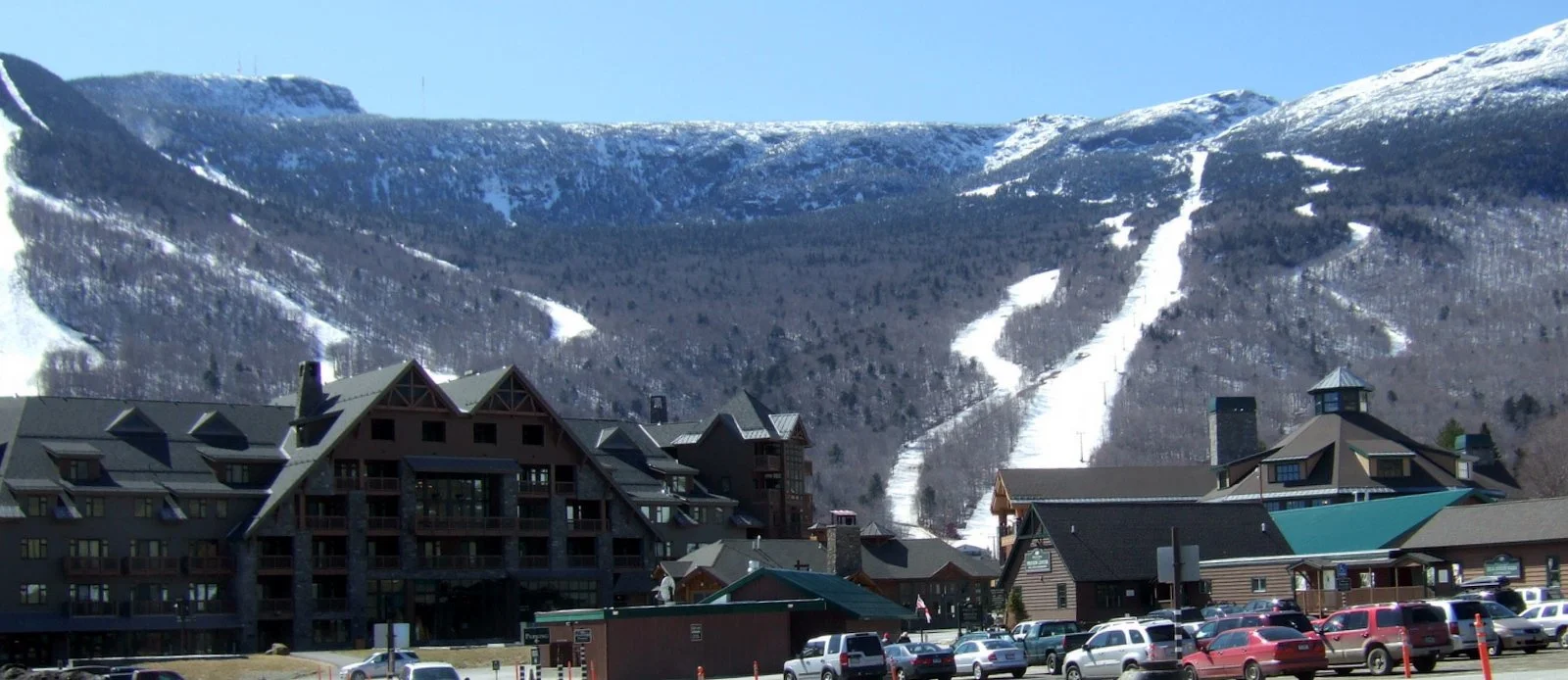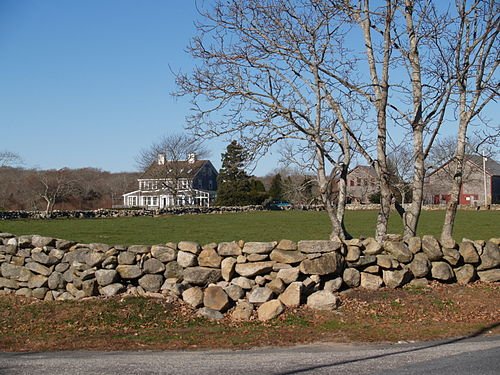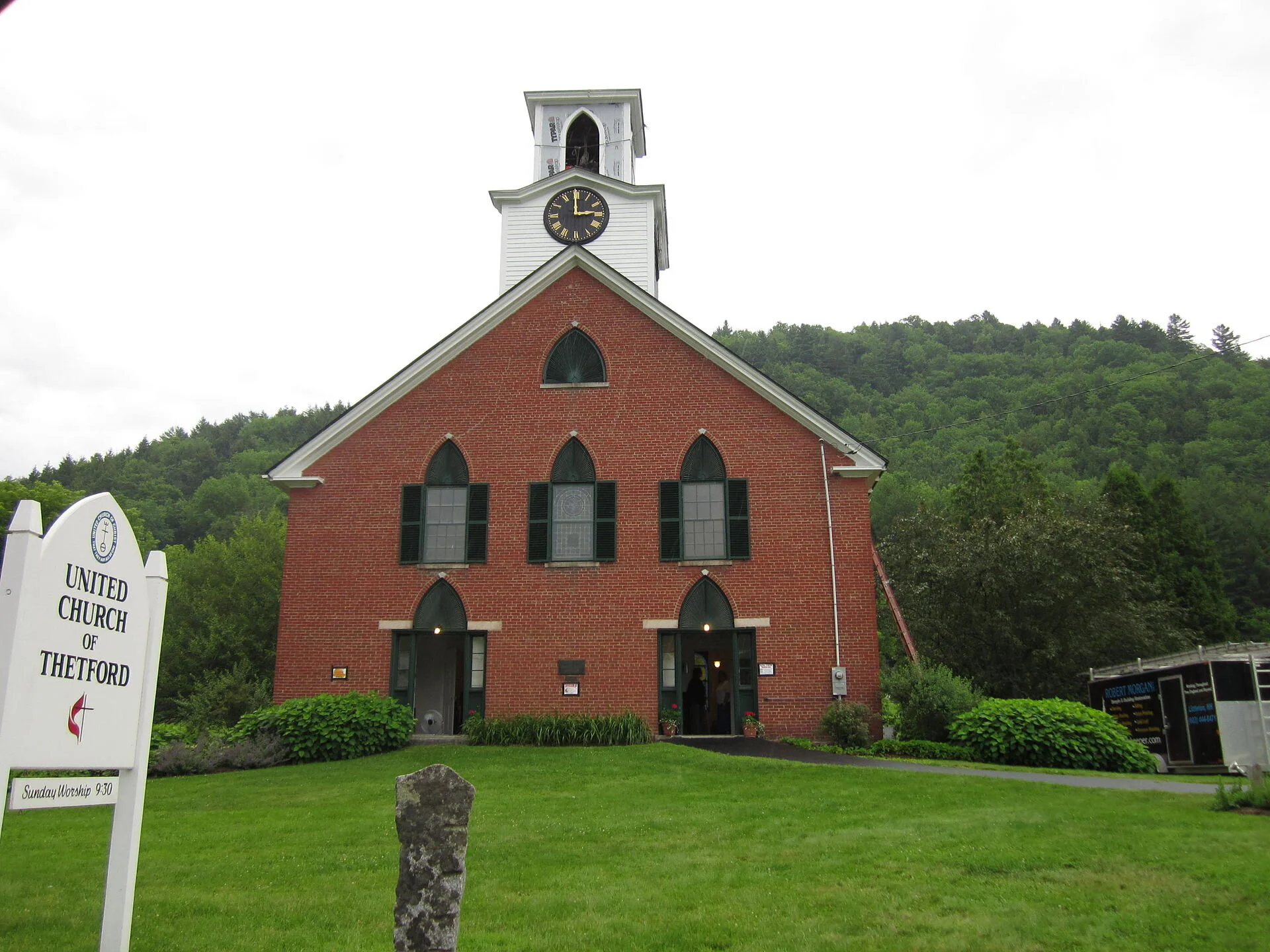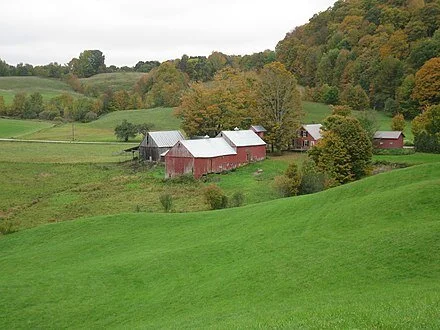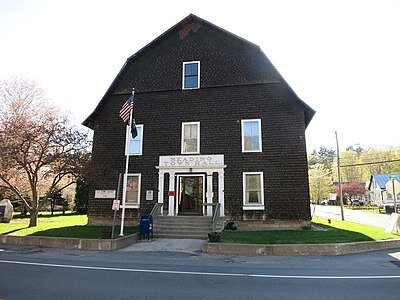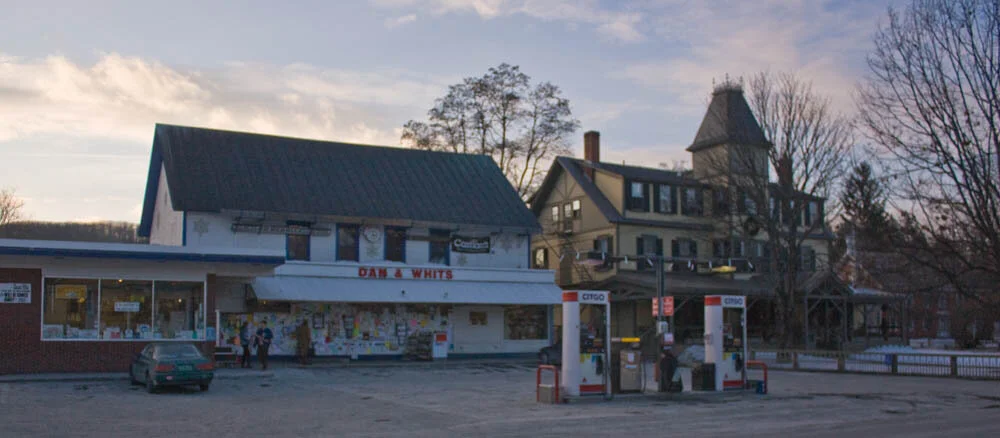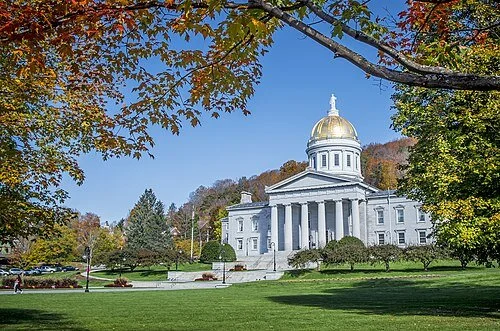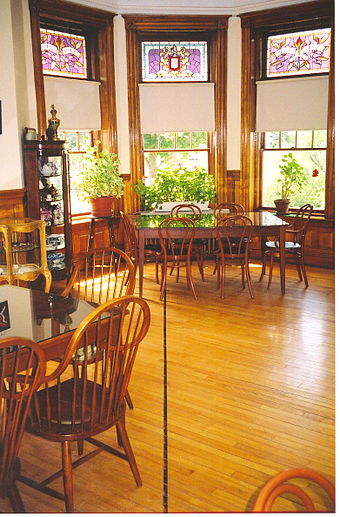
‘To which we must return’
“It is mud season. God’s yearly reminder to us of the clay from which we rose and to which we must return, hill people and Commoners alike.’’
Howard Frank Mosher (1942-1917), novelist, in Where the Rivers Flow North. Virtually everything he wrote for publication was set in Vermont’s Northeast Kingdom, where he lived in Irasburg.
Panoramic view of Willoughby Notch and Mount Pisgah, in the Northeast Kingdom
— Photo by Patmac13
‘Vermonters fear no man’
From atop Mount Equinox.
“Vermont is a state I love.
“I could not look upon the peaks of Ascutney, Killington, Mansfield and Equinox without being moved in a way that no other scene could move me.
“It was here that I first saw the light of day; here I received my bride; here my dead lie pillowed on the loving breast of our everlasting hills.
“I love Vermont because of her hills and valleys, her scenery and invigorating climate, but most of all, because of her indomitable people. They are a race of pioneers who have almost beggared themselves to serve others. If the spirit of liberty should vanish in other parts of the union and support of our institutions should languish, it could all be replenished from the generous store held by the people of this brave little state of Vermont.
“Vermont is my birthright. Here one gets close to nature, in the mountains, in the brooks, the waters which hurry to the sea; in the lakes, shining like silver in their green setting; fields tilled, not by machinery, but by the brain and hand of man. My folks are happy and contented. They belong to themselves, live within their incomes, and fear no man.’’
— President Calvin Coolidge (18720-1933) on Sept. 21, 1928. He grew up in Plymouth Notch, Vt., though he went to college (Amherst College), practiced law and rose to governor in Massachusetts.
Visit the Coolidge homestead. Hit this link.
At the Coolidge homestead, in Plymouth Notch, Vt. Calvin Coolidge was born in the rear of the general store in the foreground and the Coolidges’ still operative cheese company is in the distance.
— Photo by Swampyank
John O. Harney: The state of the New England states as COVID winds down (for now?)
Regions of New England:
1. Northwest Vermont/Champlain Valley
2. Northeast Kingdom
3. Central Vermont
4. Southern Vermont
5. Great North Woods Region
6. White Mountains
7. Lakes Region
8. Dartmouth/Lake Sunapee Region
9. Seacoast Region
10. Merrimack Valley
11. Monadnock Region
12. Aroostook
13. Maine Highlands
14. Acadia/Down East
15. Mid-Coast/Penobscot Bay
16. Southern Maine/South Coast
17. Mountain and Lakes Region
18. Kennebec Valley
19. North Shore
20. Metro Boston
21. South Shore
22. Cape Cod and Islands
23. South Coast
24. Southeastern Massachusetts
25. Blackstone River Valley
26. Metrowest/Greater Boston
27. Central Massachusetts
28. Pioneer Valley
29. The Berkshires
30. South County
31. East Bay
32. Quiet Corner
33. Greater Hartford
34. Central Naugatuck Valley
35. Northwest Hills
36. Southeastern Connecticut/Greater New London
37. Western Connecticut
38. Connecticut Shoreline
From The New England Journal of Higher Education (NEJHE), a service of The New England Board of Higher Education (nebhe.org)
BOSTON
“This Covid-19 pandemic has been part of our lives for nearly two years now. It’s what we talk about at our kitchen tables over breakfast in the morning, and again over dinner at night. It gets brought up in nearly every conversation we have throughout the day, and it’s a topic at nearly every special gathering we attend,” Rhode Island Gov. Daniel McKee noted in his recent 2022 State of the State address.
Indeed, that was a consistent theme among all six New England governors’ 2022 State of the State speeches. As were plugs for innovation in healthcare, especially mental health, housing, workforce development, climate strategies, children’s services, transportation, schools, budgets and, with varying degrees of gratitude, acknowledgement of federal infusions of relief money.
Here are links to the full New England State of the State addresses, highlighting some key points from the beat:
Connecticut Gov. Ned Lamont’s 2022 State of the State Address
“Our budget invests 10 times more money than ever before in workforce development—with a hyper focus on trade schools, apprentice programs and tuition-free certificate programs where students of all ages can earn an industry-recognized credential in half the time, with a full-time job all but guaranteed.
This investment will train over 10,000 students and job seekers this year in courses designed by businesses around the skills that they need.
This isn’t just about providing people with credentials; this is about changing people’s lives.
A stay-at-home mom whose husband lost his job earned her pharmacy tech certificate in three months and now works at Yale New Haven Hospital.
A man who was homeless was provided housing, transportation, a laptop and training. He’s now a user support specialist for a large tech company.
These are just two examples of opportunities that completely change the course of someone’s life.
We are working with our partners in the trade unions to develop programs for the next generation of laser welders and pipefitters. Building on the amazing partnership between Hartford Hospital and Quinnipiac University, we are also ramping up our next generation of healthcare workers.
I want students and trainees to take a job in Connecticut, and I want Connecticut employers to hire from Connecticut first! To encourage that, we’re expanding a tax credit for small businesses that help repay their employees’ student loans. More reasons for your business to hire in Connecticut, and for graduates to stay in Connecticut—that’s the Connecticut difference.”
Maine Gov. Janet Mills’s 2022 State of the State Address
“It is also our responsibility to ensure that higher education is affordable.
And I’ve got some ideas to tackle that.
First, I am proposing funding in my supplemental budget to stave off tuition hikes across the University of Maine System, to keep university education in Maine affordable.
Secondly, thinking especially about all those young people whose aspirations have been most impacted by the pandemic, I propose making two years of community college free.
To the high school classes of 2020 through 2023—if you enroll full-time in a Maine community college this fall or next, the State of Maine will cover every last dollar of your tuition so you can obtain a one-year certificate or two-year associate degree and graduate unburdened by debt and ready to enter the workforce.
And if you are someone who’s already started a two-year program, we’ve got your back too. We will cover the last dollar of your second year.”
Massachusetts Gov. Charlie Baker’s 2022 State of the State Address
“We increased public school spending by $1.6 billion, and fully funded the game-changing Student Opportunity Act.
We invested over $100 million in modernizing equipment at our vocational and technical programs, bringing opportunities to thousands of students and young adults.
We dramatically expanded STEM programming, and we helped thousands of high school students from Gateway Cities earn college credits free through our Early College programs.”
New Hampshire Gov. Chris Sununu’s State of the State Address
“Our way of life here in the 603 is the best of the best.
We didn’t get here by accident—we did it through smart management, prioritizing individuals over government, citizens over systems, and delivering results with the immense responsibility of properly managing our citizens tax dollars.
As other states were forced to buckle down and weather the storm, we took a more proactive approach in 2021. In just the last year, we:
• Cut the statewide property tax by $100 million to provide relief to New Hampshire taxpayers
• Cut the rooms and meals tax
• Cut business taxes—again
• Began permanently phasing out the interest and dividends tax
And while we heard scary stories of how cutting taxes and returning such large amounts of money to citizens and towns would ‘cost too much’, the actual results have played out exactly as we planned, record tax revenue pouring into New Hampshire, exceeding all surplus estimates, allowing us to double the State’s Rainy Day Fund to over $250 million.”
Rhode Island Gov. Daniel McKee’s State of the State Address
“We all know that the economy was changing well before the pandemic. A college degree or credential is a basic qualification for over 70 percent of jobs created since 2008. Although we have made great progress over the last decade, there’s more to do.
Let’s launch Rhode Island’s first Higher Ed Academy, a statewide effort to meet Rhode Islanders where they are and provide access to education and training, that leads to a good-paying job. Through this initiative, which will be run by our Postsecondary Education Commissioner Shannon Gilkey, we expect to support over a thousand Rhode Islanders helping them gain the skills needed to be successful in obtaining a credential or degree.
Having a strong, educated workforce is critical for a strong economy—and Rhode Island’s economy is built on small businesses. Small businesses employ over half of our workforce. As these businesses continue to recover from the pandemic, we know that challenges still persist. That’s why in the first several weeks of my administration, I put millions of unspent CARES Act dollars that we received in 2020 into grants to help more than 3,600 small businesses stay afloat.
My budget will call for key small business supports like more funding for small business grants, especially for severely impacted industries like tourism and hospitality. It will also increase grant funding for Rhode Island’s small farms.
As our businesses deal with workforce challenges, I’ll also propose more funding to forgive student loan debt, especially for health-care professionals, and $40 million to continue the Real Jobs Rhode Island program which has already helped thousands of Rhode Islanders get back to work.”
Vermont Gov. Phil Scott’s State of the State Address
“The hardest part of addressing our workforce shortage is that it is so intertwined with other big challenges, from affordability and education to our economy and recovery. Each problem makes the others harder to solve, creating a vicious cycle that’s been difficult to break.
Specifically, I believe our high cost of living has contributed to a declining workforce and stunted our growth. As we lose Vermonters who cannot afford to live, do business or even retire here, that burden—from taxes and utility rates to healthcare and education costs—falls on fewer and fewer of us, making life even less affordable.
With fewer working families comes fewer kids in our schools. But lower enrollment hasn’t meant lower costs and from district to district, kids are not offered the same opportunities, like foreign languages, AP courses or electives. And with fewer school offerings, it is hard to attract families, workers and jobs to those communities.
Fewer workers and fewer students mean our businesses struggle to fill the jobs they need to survive, deepening the economic divide from region to region.
And for years, state budgets and policies failed to adapt to this reality. …
Let’s start with the people already here and do more to connect them with great jobs.
First, our internship, returnship and apprenticeship programs have been incredibly successful, not only giving workers job experience, but also building ties to local employers. To improve on this work, the Department of Labor assists employers to fill and manage internships statewide and we’ll invest more to help cover interns’ wages.
And let’s not forget about retired Vermonters who want to go back to work and have a lot to offer. I look forward to working with Representative Marcotte and the House Commerce Committee on this issue and may others.
Next, let’s put a greater focus on trades training. And here’s why:
We all know we need more nurses and healthcare workers. And as I previewed with {state} Senator Sanders and {state} Senator Balint earlier this week, I will propose investments in this area. But if we don’t have enough CDL drivers, mechanics and technicians, hospital staff won’t get to work; there will be issues getting the life-saving equipment and supplies we need; and we will see fewer EMTs available to get patients to emergency rooms. If we don’t have enough carpenters, plumbers and electricians, or heating, ventilation, air handling and refrigeration techs, there are fewer to construct and maintain the facilities in our health-care system or build homes for the workers we are trying to attract.”
John O. Harney is the executive editor of The New England Journal of Higher Education.
‘Thaw through frost’
— Photo by Scoo
“Home drive. High beams shearing the bromegrass,
blackcaps, brambles by the roadside;
red stems siphon frozen ground
grown soft, a bruise beneath the smooth suede
winter peach that rolls across
the dashboard. Thaw through frost….
…Mount Equinox, Ascutney …far ahead….’’
— From “Driving Sleeping People,’’ by Richard Kenney, who has lived in western Vermont and teaches at the University of Washington.
Mount Ascutney, in eastern Vermont
Sarah Varney: Omicron hits even super-vaxxed Vermont but packs less punch
Lamoille County Superior Courthouse, in Hyde Park, Vt.
Fog in the Lamoille River valley in Hyde Park.
Even Eden, a snow-covered paradise in northern Vermont’s Lamoille County, is poisoned by Omicron. {The area was poisoned for decades by the mining of asbestos at Belvidere Mountain.}
The nearly vertical ascent of new coronavirus cases in recent weeks, before peaking in mid-January, affected nearly every mountain hamlet, every shuttered factory town, every frozen bucolic college campus in this state despite its near-perfect vaccination record.
Of all the states, Vermont appeared best prepared for the omicron battle: It is the nation’s most vaccinated state against covid, with nearly 80% of residents fully vaccinated — and 95% of residents age 65 and up, the age group considered most vulnerable to serious risk of covid.
Yet, even this super-vaxxed state has not proved impenetrable. The state in mid-January hit record highs for residents hospitalized with COVID-19; elective surgeries in some Vermont hospitals are on hold; and schools and day care centers are in a tailspin from the numbers of staff and teacher absences and students quarantined at home. Hospitals are leaning on Federal Emergency Management Agency paramedics and EMTs.
And, in a troubling sign of what lies ahead for the remaining winter months: about 1 in 10 covid tests in Vermont are positive, a startling rise from the summer months when the delta variant on the loose elsewhere in the country barely registered here.
“It shows how transmissible Omicron is,” said Dr. Trey Dobson, chief medical officer at Southwestern Vermont Medical Center, a nonprofit hospital in Bennington. “Even if someone is vaccinated, you’re going to breathe it in, it’s going to replicate, and if you test, you’re going to be positive.”
But experts are quick to note that Vermont also serves as a window into what’s possible as the U.S. learns to live with covid. Although nearly universal vaccination could not keep the highly mutated Omicron variant from sweeping through the state, Vermont’s collective measures do appear to be protecting residents from the worst of the contagion’s damage. Vermont’s COVID-related hospitalization rates, while higher than last winter’s peak, still rank last in the nation. And overall death rates also rank comparatively low.
Children in Vermont are testing positive for COVID, and pediatric hospitalizations have increased. But an accompanying decrease in other seasonal pediatric illnesses, such as influenza and respiratory syncytial virus, and the vaccinated status of the majority of the state’s eligible children, has eased the strain on hospitals that many other states are facing.
“I have to remind people that cases don’t mean disease, and I think we’re seeing that in Vermont,” said Dr. Rebecca Bell, a pediatric critical-care specialist at the University of Vermont Health Network in Burlington, the only pediatric intensive-care hospital in the state. “We have a lot of cases, but we’re not seeing a lot of severe disease and hospitalization.”
She added, “I have not admitted a vaccinated child to the hospital with COVID.”
Vermont in many ways embodies the future that the Biden administration and public health officials aim to usher in: high vaccination rates across all races and ethnicities; adherence to evolving public health guidelines; and a stick-to-itiveness and social cohesion when the virus is swarming. There is no “good enough” in Vermont, a state of just 645,000 residents. While vaccination efforts among adults and children have stalled elsewhere, Vermont is pressing hard to better its near-perfect score.
“We have a high percentage of kids vaccinated, but we could do better,” said Dobson.
He continues to urge unvaccinated patients to attend his weekly vaccination clinic. The “first-timers” showing up seem to have held off due to schedules or indifference rather than major reservations about the vaccines. “They are nonchalant about it,” he said. “I ask, ‘Why now?’ And they say, ‘My job required it.’”
Replicating Vermont’s success may prove difficult.
“There is a New England small-town dynamic,” said Dr. Tim Lahey, director of clinical ethics at the University of Vermont Medical Center in Burlington. “It’s easy to imagine how your behavior impacts your neighbor and an expectation that we take care of each other.”
While other rural states in the Midwest and South have struggled to boost vaccination rates, New England, in general, is outpacing the pack. Behind Vermont, Rhode Island, Maine and Connecticut have the highest percentage of fully vaccinated residents in the country.
“It’s something beyond just the size,” said Dr. Ben Lee, an associate professor at the Robert Larner, M.D. College of Medicine at the University of Vermont. “There is a sense of communal responsibility here that is a bit unique.”
In a state with the motto “Freedom and Unity,” freedom has largely yielded to unity, and the state’s pandemic response has been met with eager compliance. “The general attitude here has been enthusiasm to be safer,” said Lahey.
Lahey credits the state’s Republican governor, Phil Scott, who has been “unambivalent about pro-vax messaging.” Combined with a “tendency to trust the vaccine, you get a different outcome than in places where political leaders are exploiting that minority voice and whipping people up in anger.”
Vermont’s medical leaders are advising state leaders to shift from a covid war footing — surveillance testing, contact tracing, quarantines, and lockdowns — to rapprochement: testing for COVID only if the outcome will change how doctors treat a patient; ceasing school-based surveillance testing and contact tracing; and recommending that students with symptoms simply recuperate at home.
Once the Omicron wave passes and less virus is circulating, Dobson said, a highly vaccinated state like Vermont “could really drop nearly all mitigation measures and society would function well.” Vermonters will become accustomed to taking appropriate measures to protect themselves, he said, not unlike wearing seat belts and driving cautiously to mitigate the risk of a car accident. “And yet,” he added, “it’s never zero risk.”
Spared the acrimony and bitterness that has alienated neighbor from neighbor in other states, Vermont may have something else in short supply elsewhere: stamina.
“All of us are just exhausted,” said Lahey, the ethics director. But “we’re exhausted with friends.”
Sarah Varney is a Kaiser Health News journalist.
svarney@kff.org, @SarahVarney4
An ‘ordeal’ only to some
“Surely the framers of the Declaration of Independence did not have Vermonters in mind when they declared ‘all men are created equal,’ and the ordeal of winter in northern New England violates the national credo of equal justice for all.’’
Charles T. Morrissey, in Vermont: A History
Gathering around light
“Right Whale Lantern”, by Vermont-based artist and scientist Kristian Brevik in the group exhibition “Light Show.’’ at Dedee Shattuck Gallery, Westport, Mass. through Dec. 21. (North Atlantic Right Whales are in danger of extinction.)
The gallery (which is also a diversified arts center), explains:
“Light Show” is a multimedia group show with work by Adam Frelin, Kristian Brevik, Linda Schmidt, Megan Mosholder and Steven Pestana. Each of these artists utilizes light—either artificial or natural light—as a key component of their work. This exhibition, beginning after Daylight Savings Time and leading up to the winter solstice, celebrates how we create light in darkness, how we gather together and around light sources as the ever-fascinating visual medium of people across time.’’
In a rural, or at least exurban, part of Westport, which has become increasingly attractive to affluent people from Greater New York City and Greater Boston for weekend and summer places. They’re drawn by its countryside, which includes farms and vineyards, its relatively mild climate and Buzzards Bay, which is among the warmest bodies of water in New England in the summer.
LeeAnn Hall: Build back public transit much better
A Green Mountain Transit Authority bus in Montpelier, Vermont’s capital
Via OtherWords.org
If you follow the news about President Biden’s Build Back Better agenda, you might have heard a lot about its 10-year price tag. But you probably haven’t heard much about what it would actually do.
The bill will invest in care for children and seniors, cover more health care under Medicare, make the tax system more fair, and address the climate crisis. Those parts get some coverage, and they’re all worth doing.
But there’s one key thing that’s gotten almost no attention: the bill’s historic investment in public transit. This would have a tremendous positive impact on communities across the country.
The ongoing COVID-19 pandemic has hurt millions of families and their communities in many ways. One essential aspect of community life that faced an existential threat was public transportation. Systems all over the country faced massive revenue shortfalls and budget cuts.
Previous COVID rescue packages helped public transit bypass disaster. But when it comes to transit — the lifeblood of many communities and a key driver of economic growth — just avoiding disaster is not enough.
The pandemic dramatically showed that transit is vital to our communities. Essential workers depend on and operate transit, small businesses depend on transit, and historically marginalized communities depend on transit.
Transit is a key component of a more environmentally sustainable society and the road to equity for disenfranchised communities — in rural, urban, and suburban areas like. In essence, public transit has a huge impact.
Which is why what Democrats in Congress are doing right now is so vital. When you combine the bipartisan infrastructure bill already passed by the U.S. Senate with the Build Back Better plan, it results in the largest ever investment in public transit in the nation’s history.
Investments in public transit create jobs and help connect people to more job opportunities. By one estimate, every $1 billion invested in transit supports and creates more than 50,000 jobs. The larger the investment, the more people benefit.
For years, lawmakers in Washington neglected funding for buses and trains while fueling highways and cars. The result has been a transportation system that is inequitable, unsafe, unhealthy and unsustainable.
It also stunted the economic contributions of too many people, particularly in rural communities and communities of color, at a time when we can’t afford not to give everyone an opportunity to get the jobs they want.
Congress and the Biden administration can reverse this trend.
The Build Back Better plan is so much more than the numbers and political gamesmanship that is covered on TV every night. It’s something that will make people’s lives better — including by rebuilding a transit system that allows more people to move freely within their communities.
Transit is essential. Transit is our future. Congress must pass the Build Back Better plan without delay. Our communities can’t afford to wait any longer.
LeeAnn Hall is the executive director of Alliance for a Just Society and director of the National Campaign for Transit Justice.
Two tough New Yorkers transplanted to Vermont
Fall foliage at Lake Willoughby, in northern Vermont
“I was happy, but am now in possession of knowledge that this is wrong. Happiness isn’t so bad for a woman. She gets fatter, she gets older, she could lie down, nuzzling a regiment of men and little kids, she could just die of the pleasure. But men are different, they have to own money, or they have to be famous, or everybody on the block has to look up to them from the cellar stairs.’’
Grace Paley (1922-2007), American writer and teacher and native of the Bronx, in An Interest in Life. In later life, she lived in Thetford, Vt.
“If the environment were a bank, it would have been saved by now.’’
Bernie Sanders (born 1941), a native of Brooklyn who’s now a U.S. senator from Vermont (which has some of the strongest environmental protections in the country). He’s a former mayor Burlington.
‘Bring your camera’
Granny Smith apples are unusual in being green when ripe.
— Photo by Assianir
“Cider served in pounded copper mugs.
Covered bridge rides.
Pumpkin pies.
Tourists in Vermont. What do they want?
Where to find Granny Smith?
She waits for you in my tree. Bring your camera, you'll see.’’
—From “Smell the Season Sunshine,’’ by Marikate Kingston, a poet who lives in Westport, Conn.
'Histories held captive'
“Intersection” (oil on canvas), by Jeff Bye, in his show “Shenandoah,’’ at Edgewater Gallery, Middlebury, Vt., through Oct. 31.
The gallery says:
“In Vermont we have landscape painters who seek to capture and honor the natural beauty of our state. Bye has a similar focus, but his landscapes are the interior landscapes of buildings that once were inhabited and were vital to the towns and communities in which they stood but now are vacant, their histories held captive behind locked doors and boarded windows.’’
Dynamic wooden shapes
“Plaid Flannel” (carved polychromed sugar maple), by Vermont artist Clark Derbes, in his show “Time Travelers and Portals,’’ at the Hall Art Foundation, Reading, Vt., Aug. 28-Nov. 28.
The show’s organizers say: “Derbes first cuts blocks of wood from a variety of tree species, including elm, poplar and maple. Continuing to carve each block into a unique and dynamic shape, he meticulously chisels, paints, sands and burnishes each piece in order to achieve a variety of complex geometric visual systems, planes, patterns and patinas.”
The much-photographed Jenne Farm, in Reading
Reading Town Hall and post office.
Land of intimate businesses
Dan & Whit’s general store, in Norwich, Vt.
— Photo by HopsonRoad
— Vermont Congressman Peter Welch
Phil Galewitz: Biden seems in no hurry to allow import of Canadian drugs
U.S. and Canadian customs officers
The Biden administration said Friday it has no timeline on whether it will allow states to import drugs from Canada, an effort that was approved under former President Trump as a key strategy to control costs. {Many New Englanders, especially those in Maine, New Hampshire and Vermont, have long sought to be able to easily get pharmaceuticals from Canada for obvious reasons of price and proximity.}
Six states have passed laws to start such programs, and Florida, Colorado and New Mexico are the furthest along in plans to get federal approval.
The Biden administration said states still have several hurdles to get through, including a review by the Food and Drug Administration, and such efforts may face pressures from the Canadian government, which has warned its drug industry not to do anything that could cause drug shortages in that country.
The Biden administration said the lawsuit was moot because it’s unclear when or if any states would get an importation plan approved.
Drug importation has been hotly debated for decades, with many states and advocates believing it would help lower the prices Americans pay while the drug industry contends it would undercut the safety of the U.S. drug supply. Critics note most brand-name drugs sold in the U.S. are manufactured abroad.
Friday’s court filing had been eagerly anticipated, as it was the first time the Biden administration weighed in on the issue. Promises to curb high drug prices have been a standard sound bite of political campaigns, and importation enjoys broad public support. Supporters of importation range the political spectrum from progressive Sen. Bernie Sanders (I-Vt.) to Florida’s conservative Republican governor, Ron DeSantis. They argue Americans should not pay more for drugs than consumers in other countries.
Rachel Sachs, a health law expert at Washington University, in St. Louis, said the rhetoric in the court filing is probably “disheartening” to DeSantis and other supporters hoping that states’ importation programs would be approved soon. “They are laying out that there is no time limit on the FDA and there are many steps that states have to undergo before approval,” she said.
Supporters of drug importation say they still have hope, especially if the court agrees to the administration’s effort to throw out the suit.
“While articulating possible hurdles that may prevent state drug importation programs from moving forward, the Biden administration’s motion to dismiss PhRMA’s lawsuit keeps alive opportunities for more Americans to benefit from drug importation,” said Gabriel Levitt, president of Pharmacychecker.com, which verifies online foreign pharmacies for customers.
Importing drugs from Canada, where government controls keep prices lower, has been debated for decades in the U.S. A 2003 federal law gave the executive branch permission to do it, but only if certified as safe and cost-effective by the HHS secretary. Then-HHS Secretary Alex Azar announced in September that he would become the first to do that, and the department issued its rule in October.
Florida, Colorado, Maine, New Hampshire, New Mexico and Vermont are pursuing efforts to import drugs.
PhRMA filed its suit in November in the U.S. District Court for the District of Columbia. In the court filing late Friday, the Biden administration said the FDA could reject state importation plans for many reasons, including safety concerns and lack of significant savings for consumers.
In an e-mailed statement, PhRMa spokesperson Nicole Longo said: “We continue to believe the Trump Administration violated federal law when it finalized its rule permitting state-sponsored drug importation from Canada without proper certification and, in doing so, putting the health and safety of Americans in jeopardy.”
Canada has opposed efforts to send its drugs to the United States, fearing that it could exacerbate shortages there. Last year, Canadian health regulators warned companies against exporting any drugs that could lead to shortages.
During the presidential campaign, Joe Biden supported drug importation. His HHS secretary, Xavier Becerra, voted for the 2003 Canadian drug importation law as a member of Congress.
In most circumstances, the FDA says it’s illegal for individuals to import drugs for personal use.
Yet, for nearly 20 years, storefronts in Florida have helped people buy drugs online from pharmacies in Canada and other nations at typically half the U.S. price. The FDA has periodically cracked down on the operators but has allowed the stores to stay open.
The Florida legislature in 2019 approved the state drug importation program, and the state submitted its proposal to the federal government last year. While DeSantis has boasted of the strategy at news conferences in the retiree-heavy community of The Villages, the state program would have little direct effect on most Floridians.
That’s because the state effort is geared to getting lower-cost drugs to state agencies for prison health programs and other needs and for Medicaid, the state-federal health program for the poor. Medicaid enrollees already pay little or nothing for medications.
Florida has identified about 150 drugs — many of them expensive HIV/AIDS, diabetes and mental health medicines — that it plans to import. Insulin, one of the most expensive widely used drugs, is not included in the program.
DeSantis said the importation plan would save the state between $80 million and $150 million. The state has a $96 billion budget, he said.
“It’s been under review enough,” DeSantis said Friday, hours before the Biden administration’s court filing. “We have followed every regulation. We’ve met every requirement that we were asked to meet, and we want now to be able to get this final approval so that we can finally move forward.”
Christina Pushaw, a spokesperson for DeSantis, said the governor was disappointed by the Biden court filing.
“Governor DeSantis calls on the Biden Administration to step out of the way of innovation and act immediately to approve Florida’s plan that provides safe and effective drugs to drive down prescription costs,” she said in an email to KHN.
The governor appeared at LifeScience Logistics in Lakeland, Florida, where state regulators worked with the company to construct an FDA-compliant warehouse to process pharmaceuticals from Canada.
“We’re ready, willing and able, and I think that this could be really, really significant,” DeSantis said.
He said the warehouse could begin receiving drugs from Canada within 90 days if the state were to get approval from Washington.
LifeScience Logistics officials said they are working with Methapharm Specialty Pharmaceuticals, which has offices near Toronto and Fort Lauderdale, Florida, to act as its Canadian wholesaler. Quality checks would be done on the drugs in Canada and again in Florida, said Richard Beeny, CEO of LifeScience Logistics.
LifeScience has begun early talks on negotiating prices with drug manufacturers that would deliver medications to Methapharm, which in turn would send drugs to the Lakeland warehouse. “There is broad interest in the program,” Beeny said about drug companies wanting to participate. “But the pending suit is a bit of a roadblock, so we have to wait and see how that pans out.”
Unlike Florida’s plan, Colorado’s Canadian importation program would help individuals buy the medicines at their local pharmacy. Colorado also would give health insurance plans the option to include imported drugs in their benefit designs.
Mara Baer, a health consultant who has worked with Colorado on its proposal, said the Biden decision leaves open the question of whether state importation plans might eventually be approved. “HHS could have let the rule fall and they did not, which is important given the challenges facing Congress in moving major drug pricing reform in the short term,” she said.
Phil Galewitz is a journalist for Kaiser Health News
Campobello Island is an exclave of Canada’s Province of New Brunswick , but with land access to the mainland being only to Maine.
The math of Vermont
Looking south from the summit of Mt. Mansfield, at 4,396 feet the highest point in the Green Mountain State
“It takes trigonometry, solid geography, and calculus to get at Vermont.’’
— Charles Edward Crane (1884-1960) in Let Me Show You Vermont
'This brave little state'
Mt. Mansfield
“I have had an opportunity of visiting again the scenes of my childhood. I want to express to you, and through the press to the other cities of Vermont, my sincere appreciation for the general hospitality bestowed upon me and my associates on the occasion of this journey.
“It is gratifying to note the splendid recovery from the great catastrophe which overtook the state nearly a year ago. Transportation has been restored. The railroads are in a better condition than before. The highways are open to traffic for those who wish to travel by automobile.
” Vermont is a state I love. I could not look upon the peaks of Ascutney, Killington, Mansfield and Equinox, without being moved in a way that no other scene could move me. It was here that I first saw the light of day; here I received my bride, here my dead lie pillowed on the loving breast of our everlasting hills.
“I love Vermont because of her hills and valleys, her scenery and invigorating climate, but most of all because of her indomitable people. They are a race of pioneers who have almost beggared themselves to serve others. If the spirit of liberty should vanish in other parts of the Union, and support of our institutions should languish, it could all be replenished from the generous store held by the people of this brave little state of Vermont.’’
President Calvin Coolidge’s speech at Bennington, Vt., on Sept. 21, 1928. Coolidge (1872-1933) was touring his home state by train to assess progress of recovery following a disastrous flood in 1927. Considered taciturn and nicknamed "Silent Cal," Coolidge demonstrated unusual emotion in delivering his response to the suffering and loss he had witnessed.
Phil Galewitz: Vermont giving priority to minorities for COVID vaccinations
Starting April 1, Vermont has explicitly been giving Black adults and people from other minority communities priority status for vaccinations. Although other states have made efforts to get vaccine to people of color, Vermont is the first to offer them priority status, said Jen Kates, director of global health and HIV policy at the Kaiser Family Foundation (KFF). (Kaiser Health News is an editorially independent program of KFF.)
All Black, Indigenous residents and other people of color who are permanent Vermont residents and 16 or older are eligible for the vaccine.
It will be a short-term advantage, since Vermont opens COVID-19 inoculations to all adults April 19.
Still, Vermont health officials say they hope that the change will lower the risk for people of color, who are nearly twice as likely as whites to end up in the hospital with COVID-19. “It is unacceptable that this disparity remains for this population,” Dr. Mark Levine, M.D.,
Vermont’s health commissioner, said at a recent news conference.
But providing priority may not be enough to get more minority residents vaccinated — and could send the wrong message, some health experts say.
“Giving people of color priority eligibility may assuage liberal guilt, but it doesn’t address the real barriers to vaccination,” said Dr. Céline Gounder, an infectious-diseases specialist at NYU Langone Health and a former member of President Biden’s COVID advisory board. “The reason for lower vaccination coverage in communities of color isn’t just because of where they are ‘in line’ for the vaccine. It’s also very much a question of access.”
Vaccination sites need to be more convenient to where these targeted populations live and work, and more education efforts are necessary so people know the shots are free and safe, she said.
“Explicitly giving people of color priority for vaccination could backfire,” Gounder said. “It could give some the impression that the vaccine is being rolled out to them first as a test. It could reinforce the fear that people of color are being used as guinea pigs for something new.”
Dr. Georges Benjamin, executive director of the American Public Health Association, said that’s why he has opposed using race as a risk factor to determine covid vaccine eligibility.
But he sees signs that vaccine hesitancy is declining nationally and called Vermont’s new approach “admirable.” Still, he said, states should continue to use a range of options to get vaccines to minority communities, such as providing vaccination sites in Black neighborhoods and places that residents trust, like churches.
No state is achieving equity in its vaccine distribution, said KFF’s Kates.
“People of color, whether they be Black or brown, are being vaccinated at lower rates compared to their representation among covid cases and deaths, and often their population overall,” she said.
Blacks make up about 2 percent of Vermont’s population and 4 percent of its COVID infections, but they have received 1 percent of the state’s vaccines, according to KFF.
“Since states are really not doing well on equity, other strategies are welcome at this point,” said Kates.
Yet, there’s another reason public health officials have balked at explicitly giving people of color vaccine priority. “It could be politically sensitive,” she said.
Phil Galewitz is a Kaiser Health News reporter.
Phil Galewitz: pgalewitz@kff.org, @philgalewitz
Phil Galewitz: Vt., N.H. and Maine are pushing to import Canadian drugs
The Haskell Free Library and Opera House straddles the border in Derby Line, Vt., and Stanstead, Quebec. The dark line shows the exact border.
Vermont, New Hampshire and Maine, all bordering on Canada, as well as Florida and Colorado, are moving ahead with efforts to import prescription drugs from Canada, a politically popular strategy greenlighted last year by then-President Trump.
But it’s unclear whether the Biden administration will proceed with Trump’s plan for states and the federal government to help Americans obtain lower-priced medications from Canada.
During the presidential campaign, Joe Biden expressed support for the concept, strongly opposed by the American pharmaceutical industry. Drugmakers argue it would undercut efforts to keep their medicines safe.
The Pharmaceutical Research and Manufacturers of America, an industry trade group, filed suit in federal court in Washington, D.C., to stop the drug-purchasing initiatives in November. That followed the Trump administration’s final rule, issued in September, that cleared the way for states to seek federal approval for their importation programs.
Friday was the deadline for the government to respond to the suit, which could give the Biden administration a first opportunity to show where it stands on the issue. But the administration could also seek an extension from the court.
Meanwhile, Florida and Colorado are moving to outsource their drug importation plans to private companies.
Florida hired LifeScience Logistics, which stores prescription drugs in warehouses in Maryland, Texas and Indiana. The state is paying the Dallas company as much as $39 million over 2½ years, according to the contract. That does not include the price of the drugs Florida is buying.
LifeScience officials declined to comment.
Florida’s agreement with LifeScience came last fall, just weeks after the state received no bids on a $30 million contract for the job.
Florida’s importation plan calls initially for the purchase of drugs for state agencies, including the Medicaid program and the corrections and health departments. Officials say the plan could save the state in its first year between $80 million and $150 million. Florida’s Medicaid budget exceeds $28 billion, with the federal government picking up about 62% of the cost.
On Monday, the Colorado Department of Health Care Policy and Financing issued a request for companies to bid on its plan to import drugs from Canada. Unlike Florida’s plan, Colorado’s would help individuals buy the medicines at their local pharmacy. Colorado also would give health insurance plans the option to include imported drugs in their benefit designs.
Kim Bimestefer, executive director of Colorado’s Health Care Policy and Financing agency, said she is hopeful the Biden administration will allow importation plans to proceed. “We are optimistic,” she said.
Her agency’s analysis shows Colorado consumers can save an average of 61% off the price of many medications imported from Canada, she added.
Prices are cheaper north of the border because Canada limits how much drugmakers can charge for medicines. The United States lets the free market determine drug prices.
The Canadian government has said it would not allow the exportation of prescription drugs that would create or exacerbate a drug shortage. Bimestefer said that her agency has spoken to officials at the Canadian consulate in Denver and that officials there are mainly concerned about shortages of generic drugs rather than brand-name drugs, which is what her state is most interested in importing since they are among the most costly medicines in the U.S.
Colorado plans to choose a private company in Canada to export medications as well as a U.S. importer. It hopes to have a program in operation by mid-2022.
But skeptics say getting the programs off the ground is a long shot. They note that Congress in 2003 passed a law to allow certain drugs to be imported from Canada — but only if the secretary of the Department of Health and Human Services agreed it could be done safely. HHS secretaries under Presidents George W. Bush and Barack Obama refused to do that. But HHS Secretary Alex Azar gave the approval in September.
Biden’s HHS nominee, Xavier Becerra, voted for the 2003 Canadian drug-importation law when he was a member of Congress.
HHS referred questions on the issue to the White House, which did not return calls for comment.
Trish Riley, executive director of the National Academy for State Health Policy, said that states have worked hard to set up procedures to ensure drugs coming from Canada are as safe as those typically sold at local pharmacies. She noted that many drugs sold in the United States are already made overseas.
She said the Biden administration could choose not to defend the importation rule in the PhRMA court case or ask for an extension to reply to the lawsuit. “Right now, it’s murky,” she said of figuring out what the Biden team will do.
Ian Spatz, a senior adviser with consulting firm Manatt Health, questions how significant the savings could be under the plan, largely because of the hefty cost of setting up a program and running it over the objections of the pharmaceutical industry.
Another obstacle is that some of the highest-priced drugs, such as insulin and other injectables, are excluded from drug importation. Spatz also doubts whether ongoing safety issues can be resolved to satisfy the new administration.
“The Trump administration plan was merely to consider applications from states and that it was open for business,” he said. “Whether [HHS] will approve any applications in the current environment is highly uncertain.”
Phil Galewitz is a Kaiser Health News journalist.
Phil Galewitz: pgalewitz@kff.org, @philgalewitz
'An ironic pessimism'
Willem Lange
“What New England is, is a state of mind, a place where dry humor and perpetual disappointment blend to produce an ironic pessimism that folks from away find most perplexing.’’
— Willem Lange (1935-2018), New Hampshire- and Vermont-based book author, newspaper columnist (“A Yankee Notebook”), outdoorsman and northern New England NPR host. He lived in East Montpelier, Vt., from 2007 to his death. Hit this link for his pre-death Web site.
— Photo by Magicpiano
What did this year mean?
“We Who Believe in Freedom” (study acrylic on birch panel), by LMNOPI (yes — that’s her name), in the Bennington (Vt.) Museum’s show through Dec. 28 entitled “Vermont Utopias: Imagining the Future .’’ The show is part of “2020 Vision: Reflecting on a World-Changing Year,’’ a statewide initiative by the Vermont Curators Group that aims to explore how 2020 has changed the world.
Robert Frost’s grave in Bennington



